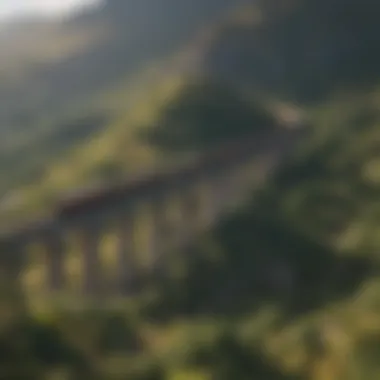Discover the Breathtaking Train Journeys of Scotland


Intro
Scotland offers a varied landscape, rich history, and culture that enchants many travelers. One of the most immersive ways to experience this beauty is through its scenic train rides. These journeys give you a chance to see a range of ecosystems, from rugged mountains to serene lochs. Along the way, you will find picturesque villages and charming towns. With this article, we will explore notable train routes, the beautiful landscapes they traverse, and practical travel tips. You will learn what makes these train rides significant for both train enthusiasts and casual travelers alike.
Scenic Train Routes in Scotland
Scotland's trains provide more than just transportation; they deliver breathtaking views and connections to the land's history. Some famous routes include:
- West Highland Line: This route is celebrated for its views of mountains and glens. It runs from Glasgow to Mallaig, passing by the famous viaduct in Glenfinnan.
- The Jacobite: A steam train experience that offers a nostalgic journey while traveling on part of the West Highland Line.
- The Highland Main Line: Connecting Inverness and Perth, this route crosses the stunning Cairngorms National Park.
These routes weave through Scotland's cultural fabric, often stopping at towns with rich histories and warm hospitality.
Landscapes Revealed
Scotland's train rides are not just about the destination; they are deeply connected to the landscape. You will see an ever-changing scenery, which includes:
- Lochs: These iconic lakes are dotted throughout the country, often reflecting the surrounding hills.
- Mountains and Glens: The rugged terrains evoke a sense of adventure and capture the wild spirit of Scotland.
- Woodlands and Fields: Lush green areas abound, showcasing Scotland's rich flora and fauna.
As the train glides through these settings, travelers gain a sense of Scotland's natural beauty and history.
Practical Tips for Travelers
Traveling on Scotland's scenic train rides can be a fulfilling experience. Here are some tips to enhance your journey:
- Booking Tickets: It’s wise to book tickets in advance, especially for popular routes like the Jacobite.
- Travel Off-Peak: If possible, choose to travel during off-peak hours or seasons to avoid crowds and enjoy a more peaceful atmosphere.
- Sightseeing Packs: Consider adding sightseeing packs that allow you to explore points of interest along the way.
In addition, being prepared with the right items, such as a camera and travel guide, will help you make the most of your experience.
Intro
Exploring the scenic train rides of Scotland is more than just an invitation to travel; it is a call to immerse oneself in a landscape steeped in rich history, cultural significance, and breathtaking beauty. Train travel offers a unique vantage point, allowing passengers to absorb the splendid scenery that unfolds like a moving tapestry. Each journey aboard these trains not only showcases the diverse topography of Scotland but also narrates the stories of the land, its people, and their traditions.
In this article, we delve into why these train rides are essential for understanding Scotland's geography and heritage. Whether it is the majestic Highland peaks or the tranquil lochs, each route provides a different experience, drawing the interest of travelers, historians, and nature enthusiasts alike. Train rides make it possible to appreciate areas that might otherwise be inaccessible, thus encouraging exploration and a deeper connection with the environment.
Tourists and locals will also find economic benefits tied to these scenic train experiences. They contribute not just to individual enjoyment but also to the vitality of regions as more and more people choose train travel for both leisure and practical reasons. This encourages investment in infrastructure and preservation of natural areas.
“The journey matters as much as the destination.” This renowned idea finds resonance in train travel across Scotland, as the ride itself becomes an integral part of the adventure.
As we explore various iconic train routes in the following sections, we will uncover the integral aspects that make these journeys a staple of Scottish tourism. By emphasizing both the cultural and natural elements present along these routes, this article aims to provide potential travelers with a comprehensive guide to planning their explorations. Each subsection will explore specific train routes, offering insights into key characteristics, landscapes, and logistical considerations.
In essence, this exploration of Scotland's scenic railways serves to highlight the importance of these journeys in enriching our understanding of Scotland—its past, present, and future. As we commence this voyage, readers can anticipate a detailed exploration that is both informative and thought-provoking.
The Allure of Scenic Train Rides
The significance of scenic train rides in Scotland extends beyond mere transportation. It encompasses a unique blend of history, culture, and breathtaking landscapes that captivate travelers. This allure is not just about getting from one place to another; it's about experiencing Scotland in its full glory. Trains offer a vantage point that is often unreachable by road, allowing passengers to witness the rugged terrains, lush valleys, and shimmering lochs in comfort.
Scenic train rides provide numerous benefits. First, they allow for a relaxed journey. Travelers can sit back, unwind, and soak in the picturesque scenery without the stress associated with driving. Additionally, these train routes connect significant cultural and historical sites, making them more than just a means of transport but a gateway to uncovering Scotland's rich heritage.
Moreover, the experience of riding a train through Scotland often brings a sense of nostalgia. Many of these train lines have been in operation for over a century. They evoke memories of a bygone era, where travel was not just about the destination but enjoying the journey itself. The rhythmic clattering of wheels on tracks alongside the gentle rocking motion creates an atmosphere conducive for reflection and appreciation of one's surroundings.
In our discussion, we will delve into its historical significance and cultural implications, further illuminating why these journeys are unique and profoundly impactful on both personal and ecological levels.
Iconic Train Routes in Scotland
The iconic train routes in Scotland are more than just transportation. They are a gateway to the remarkable landscapes and cultural heritage of this storied land. Scotland's railways are renowned for their stunning vistas and unique historical connections. Each train route offers a distinct experience that caters to various interests, including history, nature, and even cinema. Understanding these routes is essential for anyone looking to explore the true essence of Scotland from the comfort of a train.
West Highland Line
Overview


The West Highland Line is a standout among Scotland's train routes. It connects Glasgow to Mallaig, offering passengers breathtaking views of mountains and lochs throughout the journey. This route is especially significant due to its location in the rugged Highlands. The train crosses the famous Glenfinnan Viaduct, a highlight for many travelers. The experience of watching the scenery change dramatically as the train winds through Scottish landscapes is what makes this route a popular choice.
- Key Characteristics: Offers scenic views of Ben Nevis, the highest peak in the UK.
- Unique Feature: The ride over the Glenfinnan Viaduct, famous from the Harry Potter films.
However, the remoteness of some areas might concern travelers who prefer easier access to amenities.
Key Stops
Key stops along the West Highland Line include Fort William and Mallaig. Each stop provides opportunities for exploration, including walks, local cuisine, and visits to historical sites.
- Key Characteristics: Fort William is a base for climbing Ben Nevis, while Mallaig offers ferry access to the Isles.
- Unique Feature: Quaint local shops and eateries can be found, enhancing the travel experience.
These stops enrich the journey, but they may require careful planning to maximize the visit.
Noteworthy Scenery
The scenery along the West Highland Line is often described as jaw-dropping. Passengers can marvel at lakes, glens, and mountains, making every moment captivating. The tranquility of nature provides perfect backdrops for photography and reflection.
- Key Characteristics: Features Loch Awe and Rannoch Moor.
- Unique Feature: The stark contrast between the rugged Highlands and calm waters.
While immensely beautiful, unpredictable weather can sometimes hinder visibility, making some views less accessible.
Jacobite Steam Train
Historical Importance
The Jacobite Steam Train is not just a mode of transport; it represents a nostalgic link to Scotland's railway history. With operations dating back to post-war times, it has become a celebrated landmark in its own right. The steam engine evokes memories of a bygone era, encapsulating the romance of train travel.
- Key Characteristics: It operates from Fort William to Mallaig.
- Unique Feature: Vintage steam locomotion creates an authentic experience.
For history enthusiasts, this train offers a deeper appreciation of Scotland's cultural heritage. However, the travel experience can sometimes be more tourist-driven than authentic.
Movie Connections
The Jacobite Steam Train has gained fame due to its appearances in the Harry Potter films. It serves as the Hogwarts Express, attracting fans globally. This connection adds an intriguing layer to the journey, as many travelers seek the magical experience depicted in the films.
- Key Characteristics: Features in the Chamber of Secrets, among other movies.
- Unique Feature: Film memorabilia and themed experiences are available.
While the movie connection enhances its allure, it can result in crowded carriages during peak times.
Route Details
The journey on the Jacobite Train spans approximately 84 miles. Passengers enjoy views of both coastal and mountainous landscapes, showcasing nature's splendor. The route includes crossing the iconic viaduct, reinforcing its status as a premier travel experience.
- Key Characteristics: It takes about two hours each way.
- Unique Feature: The train runs over the Glenfinnan Viaduct.
Though the trip is memorable, travelers should book in advance, as tickets often sell out.
North Berwick Line
Route Overview
The North Berwick Line runs from Edinburgh to North Berwick, offering a seaside escape. This line is popular for its proximity to the coast and the delightful views of the Firth of Forth. The journey is usually quick, making it suitable for day trips.
- Key Characteristics: Scenic coastal pathways.
- Unique Feature: Direct access to the East Lothian coastline.
This route is ideal for passengers seeking a refreshing alternative to urban life. However, it may lack the dramatic landscapes found in Scotland's more mountainous areas.
Coastal Attractions
Along the North Berwick Line, several coastal attractions exist, including beaches, natural reserves, and historic sites. The journey is a feast for the eyes, with sandy shores and rugged cliffs lining the route.


- Key Characteristics: Popular beaches like Yellowcraig and Gullane.
- Unique Feature: Opportunities for watersports and relaxing walks.
These attractions enhance the overall experience, though limited train services might restrict longer explorations.
Wildlife Spotting
Travelers can encounter a variety of wildlife along the North Berwick Line. The area is known for its diverse ecosystems, making it an excellent spot for birdwatching and marine life observation. Common sightings include puffins and seals, especially around the Bass Rock.
- Key Characteristics: Presence of seabirds and coastal wildlife.
- Unique Feature: Designated nature reserves.
Wildlife enthusiasts will find this aspect highly enriching, although not all wildlife is guaranteed to be seen.
The Strathspey Steam Railway
Heritage Significance
The Strathspey Steam Railway is a gem featuring heritage steam trains. This line is vital for preserving Scotland's rail history while providing an enjoyable experience. It operates between Aviemore and Broomhill.
- Key Characteristics: A focus on traditional steam locomotion.
- Unique Feature: Restoration projects for historical locomotives.
This railway plays a crucial role in celebrating Scotland's railway culture. Nonetheless, it may not cater to those seeking modern conveniences.
Scenic Aspects
The Strathspey route traverses stunning scenery, including the Cairngorms National Park. Passengers experience a journey filled with rich landscapes, from lush forests to clear rivers.
- Key Characteristics: Prime views of the natural park.
- Unique Feature: The changing colors of the seasons add charm.
While visually spectacular, the route is not as extensive as others, limiting full-day excursions.
Visitor Information
Visitor information is available online and at the stations. Resources include timetables, ticket prices, and special events throughout the year.
- Key Characteristics: Easily accessible details for planning.
- Unique Feature: Seasonal events enhance visitor experiences.
Sound planning can enhance experiences, but incomplete information can lead to missed opportunities.
Natural Landscapes Along the Routes
The train rides through Scotland are not only about reaching a destination but are stuning journeys showcasing the natural landscapes that make this country unique. The diverse terrains provide insights into Scotland's ecological richness. The breathtaking views and variety of ecosystems encountered along these routes are crucial to understanding Scotland's identity. The vistas often leave travelers marveling at the delicate balance between nature and the effects of civilization.
Highland Peaks and Valleys
Highland peaks and valleys represent some of the most iconic scenery in Scotland. As the train meanders through this landscape, passengers are treated to sweeping views of rugged mountains rush into the horizon. The grandeur of the Highlands is characterized by its steep slopes, deep valleys, and rich geological features. Each peak tells a story of ancient formation and weathering. This region is home to notable mountains, such as Ben Nevis, the highest in the UK.
Travelers can appreciate the diverse microclimates within these valleys, ranging from healthy forests at lower altitudes to heather-covered hills at higher elevations. The varying altitudes create distinct habitats that support a wide range of flora and fauna. Visitors often feel a sense of awe as they witness these natural spectacles, and the journey through the Highlands becomes a profound experience.
Lakes and Rivers
Scotland is known for its abundant lakes and rivers, and train routes often pass close to these waterways. Distinct bodies of freshwater, such as Loch Ness and Loch Awe, offer unique opportunities for exploration. The shimmering waters reflect the surrounding mountains, creating postcard-like views throughout the journey.
Rivers like the River Spey deliver not only stunning views but also an insight into the ecosystem. They are vital for local communities and contribute significantly to the wildlife that thrives in these areas. The presence of these water bodies further enriches the travel experience, allowing observers to appreciate different aquatic ecosystems, from tranquil lakes to rapid-flowing rivers.
Wildlife and Flora
Traveling through Scotland exposes one to an impressive variety of wildlife and flora. The diverse landscapes along train routes serve as habitats for various species, some rare and unique to the region. The chance to spot red deer grazing or eagles soaring overhead adds an exciting element to these journeys. The abundance of natural forests, moors, and glens provides havens for wildlife, contributing to Scotland's reputation as a biodiversity hotspot.
Flora varies greatly depending on location. From vibrant bluebells in spring to the shades of autumnal trees, the ever-changing colors serve as a visual feast for those aboard. This rich tapestry of life is essential to the health of the ecosystems they represent.


The convergence of natural elements—mountains, water, and wildlife—creates a holistic environment that is uniquely Scottish.
The landscapes along these train routes are not just a backdrop; they represent the essence of Scotland's natural heritage and continue to fascinate travelers from around the world.
Planning Your Journey
When considering a journey through Scotland's breathtaking landscapes via train, a well-structured plan is crucial. This section emphasizes the importance of meticulous planning to enhance the travel experience. Knowledge about travel specifics fosters a better understanding of what’s ahead, ensuring smooth transitions and enjoyable encounters along the way.
Memorable train rides in Scotland are abundant, but how can one make the most of them? Factors such as the best times to visit, ticket prices, and practical travel tips all contribute to a delightful adventure. With the right preparations, travelers can immerse themselves in the scenic wonders of Scotland without unnecessary stress or complications.
Best Times to Travel
Understanding the optimal travel seasons is essential. Scotland experiences varied weather, and each season has its own charm and distinct attributes.
- Spring (March to May): The landscapes awaken from winter's slumber, presenting vibrant blooms and clear skies. Ideal for photography and wildlife spotting.
- Summer (June to August): Though popular, it can be busy. Longer days provide ample time to explore. Warm temperatures allow for comfortable travel.
- Autumn (September to November): The fall colors create stunning vistas. It's less crowded, making it a tranquil time for train journeys.
- Winter (December to February): The snow-capped scenery creates a magical atmosphere, but travelers should prepare for colder temperatures.
In summary, the best time to travel largely depends on personal preference regarding weather and crowd levels.
Ticket Booking and Pricing
Navigating ticket options can seem daunting at first. However, a grasp on how to secure tickets ahead of time can make for an efficient travel experience.
Most train services in Scotland offer online booking. Notable companies include ScotRail and the West Highland Line. Here are some key points regarding ticket options:
- Advance Purchase: Buying tickets weeks in advance usually yields cheaper prices.
- Peak Times: During holidays and weekends, prices can surge. Avoiding peak periods may result in significant savings.
- Rail Passes: Consider purchasing a ScotRail Pass for unlimited travel across various routes, which can be a cost-effective option for longer trips.
- Discounts: Many operators provide discounts for seniors, students, and groups, adding further savings potential.
Smart planning here results in a more enjoyable experience on the tracks.
Travel Tips and Recommendations
A few practical tips can go a long way in ensuring a smooth journey.
- Arrive Early: Arriving at the station with time to spare helps avoid last-minute rushes and allows time for any adjustments.
- Check Schedules: Train times can vary, especially in offseason. Always check the latest schedules before departure.
- Packing: Keep luggage light and manageable. Essentials should include a water bottle, snacks, and perhaps a camera for the stunning views.
- Social Etiquette: Be mindful of fellow passengers. Keeping conversations low and respecting personal space contributes to a pleasant atmosphere.
By considering these recommendations, travelers can maximize enjoyment and minimize hiccups as they traverse the captivating landscapes of Scotland by train.
Impact of Scenic Train Rides on Tourism
Scenic train rides serve as a cornerstone for tourism in Scotland, intertwining travel with the natural beauty of this region. With landscapes that span from rugged mountains to serene coastlines, these journeys do more than just transport passengers from point A to B. They offer a unique experience that blends cultural history, environmental appreciation, and economic growth. Understanding the impact of these train rides on tourism deepens our appreciation and highlights their significance within the broader travel industry.
Economic Benefits
The economic benefits of scenic train rides extend beyond just ticket sales. They create jobs and stimulate local economies. When tourists visit, they often spend money on accommodations, dining, and local attractions. This influx can significantly boost small towns and communities along train routes.
- Job Creation: Train operations require numerous staff, from conductors to maintenance workers. Moreover, associated businesses like hotels and restaurants also see an uptick in demand, creating more employment opportunities.
- Increased Revenue: Tourism revenues contribute to transportation infrastructure improvements. When regions become popular, local governments often invest in better facilities and services.
- Promotion of Local Culture: Scenic trains often connect travelers to local culture. Many routes feature historical landmarks or cultural events, encouraging visitors to engage with unique aspects of Scottish heritage.
In essence, the economic ripple effect from scenic train rides is profound, enriching both the travel experience and local communities.
Environmental Considerations
Scenic train rides also possess significant environmental considerations that contribute positively to sustainable tourism. Traveling by train is generally more environmentally friendly compared to cars or airplanes, reducing carbon footprints for tourists.
- Lower Emissions: Trains typically emit less greenhouse gas per passenger than cars or airplanes. This aspect aligns with the growing demand for sustainable travel options.
- Preservation of Natural Landscapes: Train operators often have a vested interest in maintaining the beauty of the landscapes they traverse. This leads to initiatives aimed at protecting local flora and fauna, ensuring that these environments remain pristine.
- Encouragement of Eco-Tourism: Many scenic trains are positioned near national parks and nature reserves, enabling access to various ecosystems. Tourists can engage in other outdoor activities, promoting eco-tourism while visiting.
The environmental impact of scenic train rides indicates a promising path towards sustainable travel. It allows tourists to explore captivating scenery while being mindful of their ecological footprint. This alignement is beneficial both for travelers and the regions they visit, highlighting the importance of scenic trains in the tourism sector.
Epilogue
The conclusion of this article underscores the significance of scenic train rides in Scotland, highlighting not only their aesthetic beauty but also their cultural and economic implications. Train journeys across this breathtaking landscape offer a unique glimpse into the rich history and vibrant traditions of the regions they traverse. Each ride represents a narrative, weaving together tales of the land and its people.
Firstly, the cultural relevance of these train rides cannot be overstated. As travelers glide through impressive vistas, they connect with Scotland's heritage. The West Highland Line, for instance, is not just a route; it's a passage through the stories of ancient clans and historical events that shaped the nation. The combination of natural beauty and cultural history captivates both train enthusiasts and casual tourists, making each journey memorable.
Moreover, these scenic routes serve as economic drivers for many local communities. They attract visitors who spend on accommodations, local eateries, and attractions, contributing to the sustainability of the regions. The Jacobite Steam Train, famous for its connection to the Harry Potter films, has seen a surge in tourism, benefiting not only the transportation sector but also ancillary services.
Environmental considerations also play an essential role in the discussion around scenic train journeys. Trains are often lauded for their lower carbon footprint compared to cars and planes. Promoting train travel can be part of a broader strategy for sustainable tourism, preserving Scotland’s natural landscapes while encouraging responsible exploration by visitors.
As travelers weigh options for experiencing Scotland, these train rides emerge as more than mere transportation. They offer a holistic experience blending culture, nature, and economy. It is vital for potential travelers to recognize the intrinsic value of each route and to appreciate the intricate interplay of history, community, and environment that represents the essence of Scotland.















